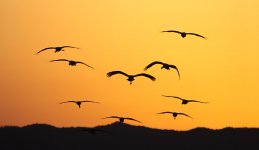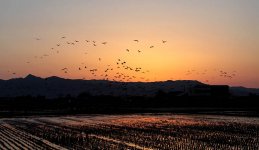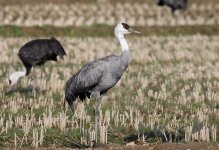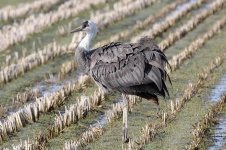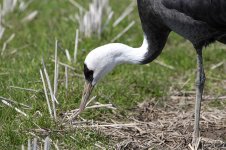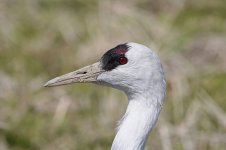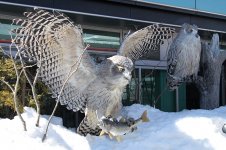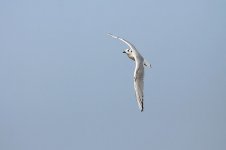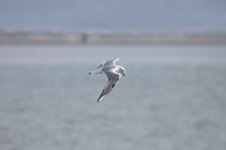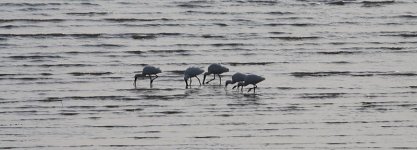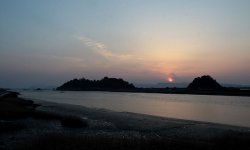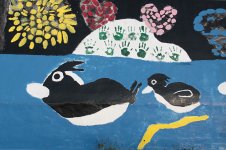13 March. Arasaki.
Arriving at Arasaki late in the evening of the 12th, the total silence was a little worrying – numerous reports speak of atmospheric nights to a backdrop of the calls of cranes. But here, at the key wintering site of many thousands of Hooded Cranes and several hundred White-naped Cranes, I heard not a peep all night. Had I left it a little late in the season? Had they all migrated?
Waking at 5.00 a.m., a little confused why it was still pitch black, it took me a few moments to appreciate that Kyushu is not only much further south than Hokkaido, but also much further west – sunrise and sunset are basically an hour later! So, sitting there in the dark, pondering the silence outside, I was rather pleased when the first traces of orange began to flood the sky and, simultaneously, the unmistakeable cries of cranes began to echo out. Within moments, the sky was full of noise and wings ...hundreds of cranes, then thousands and thousands, were falling out of the sky, spirally downward to settle in the rice paddies aside the Arasaki crane centre. Where they had spent the night I do not know, but now the spectacle was simply awesome! As the sun broke the horizon, flocks continued to pour in, the dark shapes now transforming into identifiable birds – Hooded Cranes. Jam-packed into a patch of paddies barely the size of a couple of football pitches, it was a mad scrum of birds, a carpet of slate grey stretching far, countless heads and necks poking up ...never have I seen quite so many cranes in such a small area! As the sun rose yet further and the flock expanded ever more, I relocated a little to view from another angle. Within this mass of birds, there should also be a thousand of so White-naped Cranes and possibly a Common Crane or two, perhaps Sandhill Crane too. With the birds packed so densely however, it was actually very difficult to sift through the birds – I was now looking at perhaps 10,000 Hooded Cranes, a figure representing about 80-90% of the global population, but where were the White-naped Cranes? After a while, finally finding only a single individual, I had to conclude that these indeed had probably already begun their migration. The one White-naped Crane I did see however was quite a stunner – taller and more elegant than the Hooded Cranes, I was quite happy that at least this individual had been good enough to delay his migration for me!
At about 8.am., the reason for their mass congregation appeared, a truck that trundled up the embankments through the paddies disgorging vast quantities of grain. And the feeding frenzy that followed was impressive – Hooded Cranes shoulder to shoulder, masses of Rooks squeezing into gaps on the fringes, yet more birds still flying in. Quite how I spotted them, I am not sure, but also found two Common Cranes in their midst and had a very smart Sandhill Crane stalk straight through my scope view on one occasion. The Common Cranes, and a a couple of Common-Hooded Crane hybrids I managed to relocate a few times, but never again did I see the Sandhill Crane – pretty much the same size as the Hooded Cranes, once he had vanished into the pack, that was it! By 9 a.m., with most feeding over, the cranes began to spill out into neighbouring paddies and also to paddies beyond the nearby river. Hooded Cranes would be my constant companions for the whole day, but their departure from the feeding site also served as cue for me to widen my activities ...plenty more birds to also see at Arasaki!
Dusky Thrushes by the dozen, Japanese Skylarks singing high on the wing, flocks of Oriental Greenfinch commonplace, Daurian Redstarts flitting along edges of scrubby ditches. Nice birds all, but even better, one of the first birds I found was a Chestnut-eared Bunting feeding at the edge of a paddy field, suitably backed up by rather more abundant Meadow Buntings and Black-faced Buntings. Along the reeded fringes of a river loop north-west of the crane centre, Pallas's Reed Bunting and a very smart Green Pheasant were, plus a couple of Bull-headed Shrikes, more Daurian Redstarts and my first Red-bellied Rock Thrush of the trip (more to follow in subsequent days). All in all, the next few hours were just fantastic, Hooded Cranes everywhere, spirals of Black-eared Kites overhead, cocktails of familiar and unfamiliar birds at every turn – Ospreys, Northern Lapwings, Oriental Turtle Doves, Japanese Bush Warblers, plus many more. A slight disappointment came with the discovery of two spoonbills roosting in a wet ditch – I had high hopes of a black face peering up at me when I checked them out, but alas they were both Eurasian Spoonbills ...not a bad species, but in the Far East they could have been even more exciting!
Mid-afternoon, I departed ...one more important site to squeeze in on this day.







